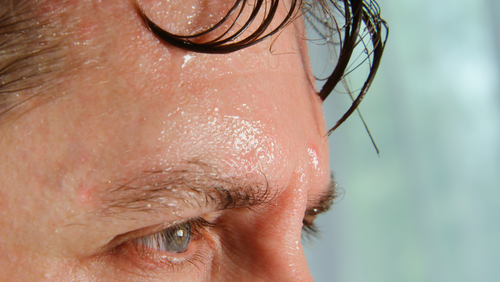Nerve Cell Loss May Contribute to Sweating Problems in Fabry Patients, Especially Women
Written by |

Reduced sweating observed in Fabry patients may be a consequence of nerve cell loss in sweat glands, particularly in women, a study has found.
The study, “Quantification of sweat gland innervation in patients with Fabry disease: A case-control study,” was published in the Journal of the Neurological Sciences.
Is not uncommon for patients with Fabry disease to experience reduced sweating and heat intolerance, also accompanied by impaired production of tears and saliva.
This is thought to occur due to the characteristic accumulation of a type of fat called globotriaosylceramide (Gb3) — a hallmark of Fabry disease — in sweat glands, but also as a consequence of nerve cell damage.
Sweat glands are controlled by the nervous system and regulate body temperature. When internal temperature rises, these glands secrete water to the skin surface (sweat) where heat is removed by evaporation.
Researchers compared skin biopsies of 37 patients with confirmed Fabry disease to 16 healthy volunteers. The participants were recruited at the University of Würzburg, in Germany, and at the National and Kapodistrian University of Athens, in Greece.
Among Fabry patients, 16 had impaired capacity to sweat, 27 suffered with pain, and eight had symptoms consistent with peripheral nerve damage.
Twelve of the 22 patients who started treatment with enzyme replacement therapy with Replagal (agalsidase alfa) or Fabrazyme (agalsidase beta) during the study experienced improvements in sweating.
Researchers counted the number of nerve fibers in sweat glands in small skin tissue samples collected from all participants. Patients had a tendency to have fewer nerve cells in their sweat glands than healthy controls.
Next, the team compared the numbers obtained with patients’ clinical sweating status.
No association was found in male patients, whereas in the females the number of nerve fibers in sweat glands were associated significantly with the clinical outcome.
Female patients who had a normal sweating response had the highest number of nerve fibers in sweat glands. In contrast, those who were unable to sweat were the ones with the lowest numbers.
Seven patients who were treated with enzyme replacement therapy were reassessed one to four years after treatment. In general, the number of fibers increased slightly at follow-up. But on an individual level, each patient showed different responses, with two patients showing improvements, two increased deterioration, and three no differences between baseline and follow-up analysis.
These results suggest that “loss of sweat gland innervation may play a role in Fabry disease associated anhidrosis [inability to sweat], at least in women,” researchers wrote.





